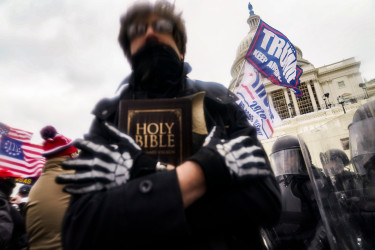On Wednesday afternoon, as insurrectionists assaulted the Capitol, a man wearing a brown vest over a black sweatshirt walked through the halls of Congress with the Confederate battle flag hanging over his shoulder. One widely circulated photo, taken by Mike Theiler of Reuters, captured him mid-stride, part of the flag almost glowing with the light coming from the hallway to his left. Just above and behind him is a painting of Charles Sumner, the ardent abolitionist senator from Massachusetts.
On May 22, 1856, Sumner was attacked by Preston Brooks—a pro-slavery member of the House of Representatives from South Carolina—for a speech Sumner had made criticizing slaveholders, including Brooks’s cousin Andrew Butler, a senator representing South Carolina.* Brooks attacked Sumner on the Senate floor. “Mr. Sumner, I have read your speech twice over carefully. It is a libel on South Carolina, and Mr. Butler, who is a relative of mine,” he said. Before Sumner could fully respond, Brooks began beating him over the head with the golden head of his thick walking cane, trapping Sumner under his desk as he tried to escape, until two representatives were finally able to intervene and bring him out of the chamber. Sumner did not return to the Senate for three years, and would experience ongoing, debilitating pain for the rest of his life.
Also behind the man in Wednesday’s photo, partially obscured by the rebel flag, is a portrait of John C. Calhoun. A senator from South Carolina and the vice president under both John Quincy Adams and Andrew Jackson, Calhoun wrote in 1837: “I hold that in the present state of civilization, where two races of different origin, and distinguished by color, and other physical differences, as well as intellectual, are brought together, the relation now existing in the slaveholding States between the two, is, instead of an evil, a good—a positive good.”
The fact that this photo was taken the day after voters in Georgia chose the first Black person and the first Jewish person in the history of that state to serve in the Senate; that it shows a man walking past the portrait of a vice president who urged the country to sustain human bondage and another portrait of a senator who was nearly beaten to death for standing up to the slavocracy; that it portrays a man walking with a Confederate flag while a mob of insurrectionists pushed past police, broke windows, vandalized offices, stole property, and strolled through the halls of Congress for hours, forcing senators and representatives into hiding and stopping the certification of the electoral process—it is almost difficult to believe that so much of our history, and our current moment, was reflected in a single photograph.
























